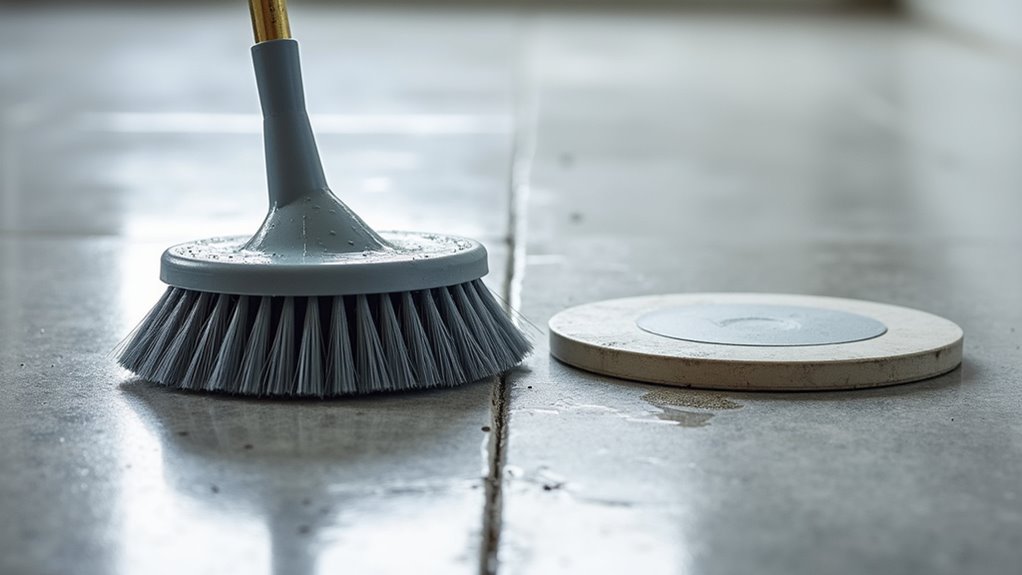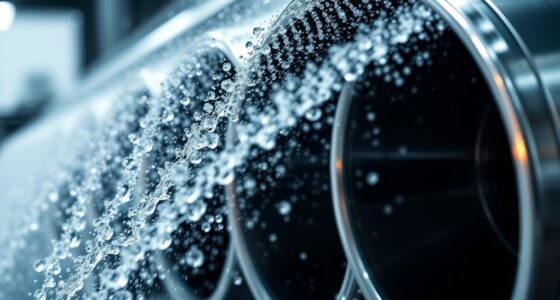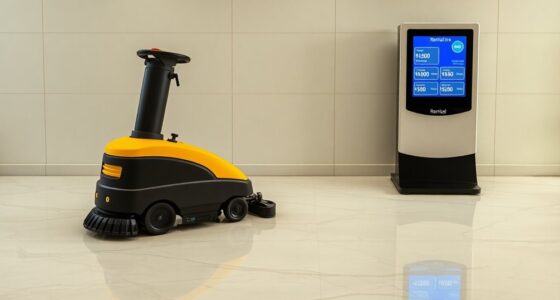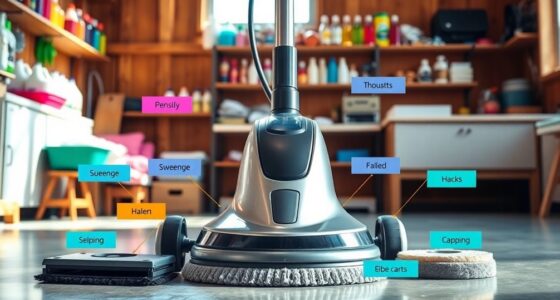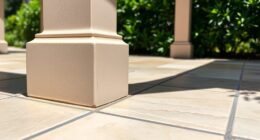When choosing between cylindrical and disc tools for polished concrete, disc tools generally clean better because they provide more precise, uniform surface finishing and high-gloss results. Cylindrical tools are faster for rough cleaning and initial surface prep but may leave scratches or uneven textures. If you want a smooth, polished look with professional quality, disc tools are your best bet. To discover which tool suits your project and ends with a perfect finish, keep exploring the details ahead.
Key Takeaways
- Cylindrical tools remove surface imperfections quickly but may leave scratches, requiring further refinement.
- Disc tools provide more precise cleaning and polishing, resulting in a smoother, more uniform finish.
- For deep cleaning and rough surface prep, cylindrical tools are more effective.
- Disc tools excel at detailed cleaning and achieving a high-gloss polished look.
- Combining both tools optimizes cleaning efficiency and surface quality on polished concrete.
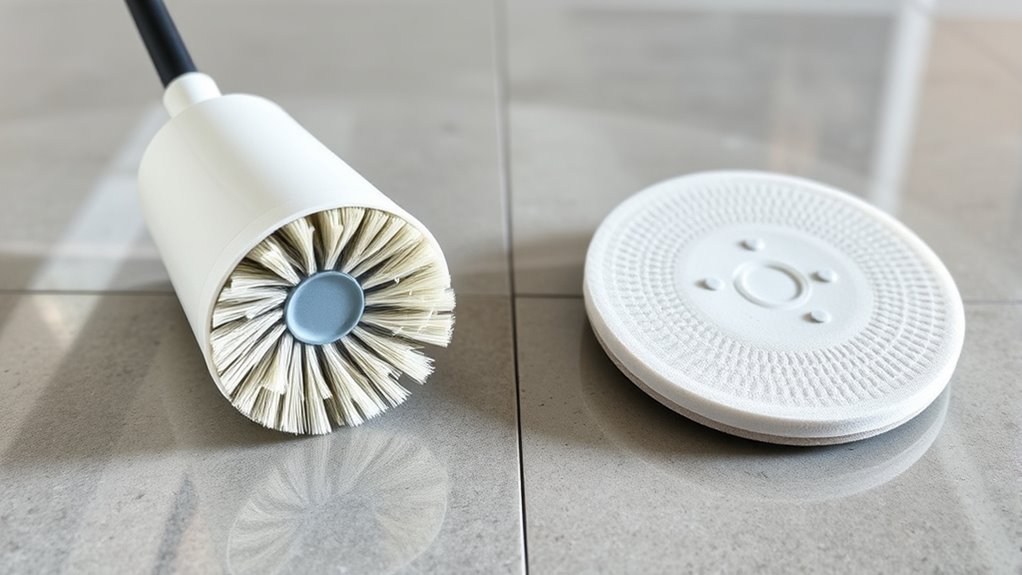
When choosing between cylindrical and disc tools for polishing concrete, understanding their differences can substantially impact your results. Both tools serve the purpose of surface finishing, but they do so in distinct ways that influence abrasive effectiveness and the quality of the polished surface. Your choice hinges on the specific project demands, the type of finish you want, and the level of detail you require.
Choosing between cylindrical and disc tools depends on your project’s specific finishing needs and surface condition.
Cylindrical tools are designed to cover large areas efficiently. They typically feature a rotating drum wrapped with abrasive pads or brushes, making them excellent for initial grinding and smoothing rough surfaces. Their abrasive effectiveness comes from the continuous contact with the surface, allowing them to remove significant imperfections quickly. If you’re dealing with a heavily damaged or uneven surface, cylindrical tools can accelerate the process and make it easier to prepare the concrete for finer polishing stages. However, their surface finishing capabilities are generally more aggressive, which means you need to be cautious to avoid creating uneven textures or gouges on the surface.
Disc tools, on the other hand, excel at detailed surface finishing. They often come with various abrasive pads that can be swapped out depending on the desired finish level. Disc tools are more versatile for fine polishing, offering better control over the surface texture. Their abrasive effectiveness is more precise, allowing you to achieve a smoother, more uniform surface. Since they can operate at different speeds and with varying grit sizes, disc tools are ideal for refining the surface after initial grinding. They produce less aggressive cuts, reducing the risk of over-polishing or creating uneven areas, and are better suited for producing a high-gloss, mirror-like finish. Additionally, disc tools can help minimize surface scratches and marks, resulting in a more professional and durable polished surface.
In terms of cleaning and maintaining the surface, disc tools tend to leave a more refined and consistent finish, making subsequent sealing or coating easier. Cylindrical tools, while powerful, can sometimes leave behind scratches or marks that require additional refinement. If your goal is to achieve a polished look that’s both aesthetically pleasing and durable, disc tools often provide better surface finishing results.
Ultimately, your choice should be guided by the condition of the concrete and the final look you want. Use cylindrical tools for rapid removal of imperfections and initial shaping, then switch to disc tools for detailed finishing to achieve a smooth, polished surface. When you understand how each tool’s abrasive effectiveness and surface finishing capabilities align with your project needs, you’ll be better equipped to select the right tool and get professional-quality results. For optimal results, consider proper tool maintenance to extend the lifespan of your equipment and ensure consistent performance.
Frequently Asked Questions
How Do Cylindrical and Disc Tools Impact Concrete Surface Durability?
You impact concrete surface durability based on your choice of cylindrical or disc tools, which affect abrasion resistance and surface integrity. Cylindrical tools tend to distribute pressure evenly, preserving surface integrity and enhancing abrasion resistance. Disc tools may create localized wear, potentially compromising durability over time. Your selection influences how well the concrete withstands use, with cylindrical tools generally offering better protection against damage and maintaining surface strength longer.
Can Different Polishing Machines Affect Cleaning Efficiency?
Sure, your cleaning machine’s efficiency isn’t just about brand names. Different polishing machines, with their abrasive materials and ergonomics, can make or break your cleaning game. You might think all machines are equal, but the right one adapts to your needs, offering better coverage and comfort. Ironically, choosing the wrong machine could turn your spotless floor into a frustrating battlefield of ineffective scrubbing.
What Maintenance Is Required for Cylindrical Versus Disc Equipment?
You’ll need to regularly inspect and clean both cylindrical and disc equipment to guarantee equipment longevity. Replace worn-out parts promptly and keep them well-lubricated to prevent damage. Proper maintenance minimizes downtime and boosts cost effectiveness. Additionally, avoid overworking the machines and follow manufacturer guidelines for routine checks. Doing this helps your equipment last longer, performs better, and saves you money in the long run.
Are Certain Tool Types Better for Specific Stains or Contaminants?
You’ll find that certain tool types work better for specific stains or contaminants. For tougher grime, opt for a disc with a coarser abrasive grit and use appropriate cleaning solutions to loosen dirt. For lighter stains, a cylindrical tool with finer grit suffices, helping to clean without damaging the surface. Matching the tool’s abrasive grit and cleaning solutions to the stain guarantees effective, efficient cleaning on polished concrete.
How Does Operator Skill Influence the Cleaning Results of Each Tool?
Your operator proficiency and tool handling techniques greatly influence cleaning results. Even the best cylindrical or disc tools can underperform if you lack experience or proper technique. Mastering proper tool handling ensures you can adapt to different stains and surfaces, maximizing cleaning efficiency. With skill, you can release the full potential of each tool, achieving a deeper, more thorough clean—turning a routine job into a showcase of expert craftsmanship.
Conclusion
Ultimately, choosing between a cylindrical and disc tool depends on your specific cleaning needs. Both can do the job effectively, but remember, “a smooth sea never made a skilled sailor.” If you want precision and thoroughness, go for the disc; for versatility, the cylindrical might be your best bet. Whichever you pick, stay consistent and attentive—cleaning is a craft, and practice makes perfect. Your polished concrete will thank you for it.
